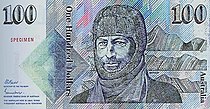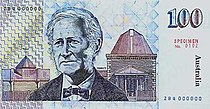The Kwacha is the currency of Zambia. It is subdivided into 100 Ngwee.

The Australian dollar is the official currency and legal tender of Australia, including all of its external territories, and three independent sovereign Pacific Island states: Kiribati, Nauru, and Tuvalu. In April 2022, it was the sixth most-traded currency in the foreign exchange market and as of Q4 2023 the seventh most-held reserve currency in global reserves.

The Singapore dollar is the official currency of the Republic of Singapore. It is divided into 100 cents. It is normally abbreviated with the dollar sign $, or S$ to distinguish it from other dollar-denominated currencies. The Monetary Authority of Singapore (MAS) issues the banknotes and coins of the Singapore dollar.

The United States one-hundred-dollar bill (US$100) is a denomination of United States currency. The first United States Note with this value was issued in 1862 and the Federal Reserve Note version was first produced in 1914. Inventor and U.S. Founding Father Benjamin Franklin has been featured on the obverse of the bill since 1914, which now also contains stylized images of the Declaration of Independence, a quill pen, the Syng inkwell, and the Liberty Bell. The reverse depicts Independence Hall in Philadelphia, which it has featured since 1928.

The Mauritian rupee is the currency of Mauritius. One rupee is subdivided into 100 cents. Several other currencies are also called rupee.

The Portrait Series of currency notes is the fourth and current set of notes to be issued for circulation in Singapore. It was first introduced on 9 September 1999 by the Board of Commissioners of Currency, Singapore (BCCS), whose role was since taken over by the Monetary Authority of Singapore (MAS) post-merger.
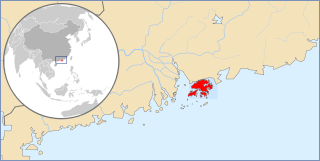
The issue of banknotes of the Hong Kong dollar is governed in the Special Administrative Region of Hong Kong by the Hong Kong Monetary Authority (HKMA), the governmental currency board and central bank of Hong Kong. Under licence from the HKMA, three commercial banks issue their own banknotes for general circulation in the region. Notes are also issued by the HKMA itself.
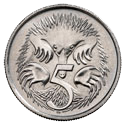
The Australian five-cent coin is the lowest-denomination circulating coin of the decimal Australian dollar introduced in 14 February 1966, replacing the pre-decimal sixpence. It has been the lowest-denomination coin in general circulation since the withdrawal of the one-cent and two-cent coins in 1992.
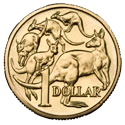
The Australian one-dollar coin is the second most valuable circulation denomination coin of the Australian dollar after the two-dollar coin; there are also non-circulating legal-tender coins of higher denominations.
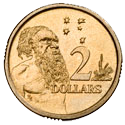
The Australian two-dollar coin is the highest-denomination coin of the Australian dollar. It was first issued on 20 June 1988, having been in planning since the mid-1970s. It replaced the Australian two-dollar note due to having a longer circulatory life. The only "mint set only" year was 1991.

The Australian fifty-dollar note is an Australian banknote with a face value of fifty Australian dollars ($50). Since 1995 it has been a polymer banknote featuring portraits of Edith Cowan, first female member of an Australian parliament, and inventor and Australia's first published Aboriginal Australian author, David Unaipon. The $50 banknote is also called a "pineapple" given its bright yellow colour.

The Australian twenty-dollar note was issued when the currency was changed from the Australian pound to the Australian dollar on 14 February 1966. It replaced the £10 note which had similar orange colouration. There have been only three different issues of this denomination: a paper note which had a gradient of yellow and red, with a distinct orange background, and two designs of polymer note which can be recognised for their distinct red-orange colouration, and so it was nicknamed a "lobster". The first polymer note was issued on 31 October 1994 and the Next Generation polymer banknote was issued on 9 October 2019.

The Australian ten-dollar note was one of the four original decimal banknotes excluding the Australian five-dollar note, was issued when the currency was changed from the Australian pound to the Australian dollar on 14 February 1966. It replaced the Australian five-pound note, which included the same blue colouration. There have been four different issues of this denomination: a paper banknote; a commemorative hi-polymer note, to celebrate the bicentennial of Australian settlement ; the 1993–2017 polymer note; and from September 2017 a polymer note featuring a transparent window.

The cent, formally the one-cent coin, was the lowest-denomination coin of the Australian dollar. It was introduced on 14 February 1966 in the decimalisation of Australian currency and was withdrawn from circulation in 1992. It is still minted as a non-circulating coin. A one-cent coin in 1966 would have a purchasing power equal to about 16c in 2023 values.
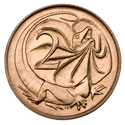
The Australian two-cent coin was introduced in 1966 and was the coin of the second-lowest denomination until it was withdrawn from circulation in 1992. It is still counted as legal tender, but is subject to some restrictions, and two-cent coins are legal tender only up to the sum of 20 cents.
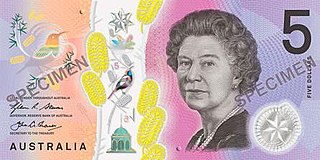
The Australian five-dollar note was first issued on 29 May 1967, fifteen months after the currency was changed from the pound to the dollar on 14 February 1966. It was a new denomination with mauve colouration – the pre-decimal system had no denomination with a value of £21⁄2. The first polymer version of the note was introduced on 7 July 1992. A major design update was issued on 1 September 2016, with a minor update to the signatures in 2019.
The notes of the Australian dollar were first issued by the Reserve Bank of Australia on 14 February 1966, when Australia changed to decimal currency and replaced the pound with the dollar. This currency was a lot easier for calculating compared to the previous Australian pound worth 20 shillings or 240 pence.

The banknotes of Zimbabwe were physical forms of Zimbabwe's first four incarnations of the dollar, from 1980 to 2009. The banknotes of the first dollar replaced those of the Rhodesian dollar at par in 1981, one year after the proclamation of independence. The Reserve Bank of Zimbabwe issued most of the banknotes and other types of currency notes in its history, including the bearer cheques and special agro-cheques that circulated between 15 September 2003 and 31 December 2008: the Standard Chartered Bank also issued their own emergency cheques from 2003 to 2004.

The Indian 1000-rupee banknote is an obsolete denomination of the Indian rupee. It was first introduced by the Reserve Bank of India in 1938 under British rule and subsequently demonetized in 1946. Post-independence, the denomination was re-introduced in 1954. In January 1978, all high-denomination banknotes of ₹1000,5000, and 10000 were demonetized in order to curb unaccounted cash money.

The Indian 100-rupee banknote is a denomination of the Indian rupee. It has been in continuous production since Reserve Bank of India took over the functions of the controller of currency in India in 1935. The present ₹100 banknote in circulation is a part of the Mahatma Gandhi New Series.


